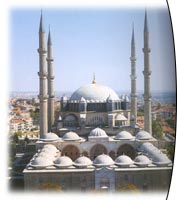CS 411:
Software
Architecture
Design
Instructor:
Dr. Bedir Tekinerdoğan
bedir@cs.bilkent.edu.tr
Course Assistants
Bugra M. Yıldız
Elif Demirli
Mimar Sinan
Who doesn't know the famous turkish architect? The master architect to four sultans.
| Mimar Koca Sinan, the "Great Architect Sinan", was born in Anatolia, Turkey in 1489. He is an architect who grew up in one of the most splendid periods of the Ottoman State, and who contributed to this era with his works. He served first under Selim II. It was this which was to shape the future of Ottoman architecture as he was exposed, during his travels, to the architecture of Iraq and Corfu, of Baghdad and Belgrad, combining this with the architectural experience of the Byzantine legacy in Istanbul. Sinan, who held the position of chief architect of the palace, which meant being the top manager of construction works of the Ottoman Empire, for nearly 50 years, worked with a large team of assistants consisting of architects and master builders. |
|
Various sources state that Sinan was the architect of around 360 structures which included 84 mosques, 51 small mosques ("mescit"), 57 schools of theology ("medrese") 7 schools for Koran reciters ("darülkurra"), 22 mausoleums ("türbe"), 17 Alm Houses ("imaret"), 3 hospitals ("darüşşifa"), 7 aquaducts and arches, 48 inns ("Caravansary"), 35 palaces and mansions, 8 vaults and 46 baths. Of this diverse group of works, his mosques have been most influential and represent the archetypal image of Turkish Ottoman architecture. He often designed his mosques as part of a complex comprising schools, baths, guesthouses and hospitals. Sinan absorbed existing architectural values and interpreted them in truly unique forms. He is usually associated with structural experiment, and certainly took the domed form to its logical conclusion. But unlike his European contemporary Palladio, this architect was not to give his name to a style. There is no need as his work is totally identified with the structural and ornamental clarity of the period.
Mimar Sinan was summing up his own work as an architect as centred around the three mosques of Shezade, Süleymaniye and Selimiye the first as a product of an apprentice, the second that of a trainee master, and the third as that of a master craftsman. Şehzade Mosque is the first of the grand mosques Sinan has created. Mihriman Sultan Mosque which is also known as the Üsküdar Quay Mosque was completed in the same year and has an original design with its main dome supported by three half domes. When Sinan reached the age of 70, he had completed the Süleymaniye Mosque and the Complex. This building, situated on one of the hills of İstanbul facing the Golden horn, and built in the name of Süleyman the Magnificent, is one of the symbolic monuments of the period. The diameter of the dome which exceeds 31 meters at Selimiye Mosque which Sinan completed when he was 80, is the most significant example of the level of achievement Sinan reached in architecture. Mimar Sinan has reached his artistic summit with the design, architecture, tile decorations, land stone workmanship displayed at Selimiye.
Another area of architecture where Sinan delivered unique projects are the mausoleums. Mausoleum of Şehzade Mehmed gets attention with its exterior decorations and sliced dome. Rüstem Paşa mausoleum is a very attractive structure in classical style. The mausoleum of Süleyman the Magnificent which is one of his interesting experimentations has an octagonal body and flat dome. Selim II Mausoleum with has a square plan and is one of the best examples of Turkish mausoleum architecture. Sinan's own mausoleum which is located at the north - east part of the Süleymaniye complex on the other hand, is a very plain structure.
Sinan, in the bridges he built, has masterfully combined art with functionalism. The largest of his work in this group is the nearly 635 m. long Büyükçekmece Bridge. Other significant examples are Ailivri Bridge, Lüleburgaz (Sokullu Mehmet Pasha) Bridge on Lüleburgaz River, Sinanlı Bridge over Ergene River and Drina Bridge.
While Sinan was maintaining and improving the water supply system of İstanbul, he has built arched aqueducts at several locations within the city. Mağlova Arch over Alibey River, which is 257 meter long, 35 meters high and displaying two layers of arches is one of the best samples of its kind. He not only created great monumental works, but also added to the existing structures of the capital, Topkapi and Haghia Sophia in particular. Most important, he trained a school of architects, including his apprentices Davut Aga, Dalgic Ahmet and Mehmet Aga who were to carry his structural experiments into a future age in such post-classical masterpieces as the New Mosque, the mausoleum of Murad II and the Sultan Ahmet mosque.
Sinan died in Istanbul, Turkey in 1588.

